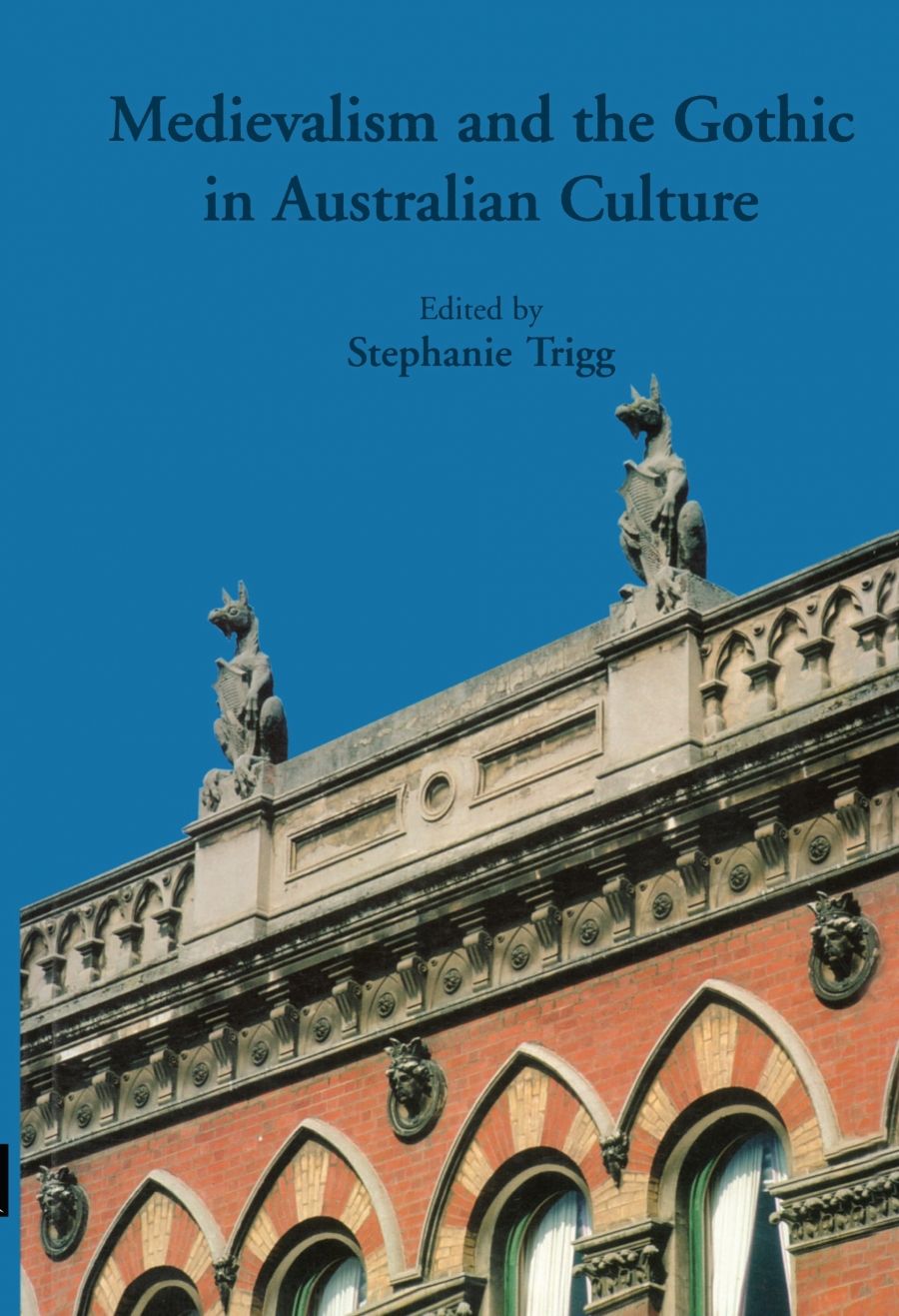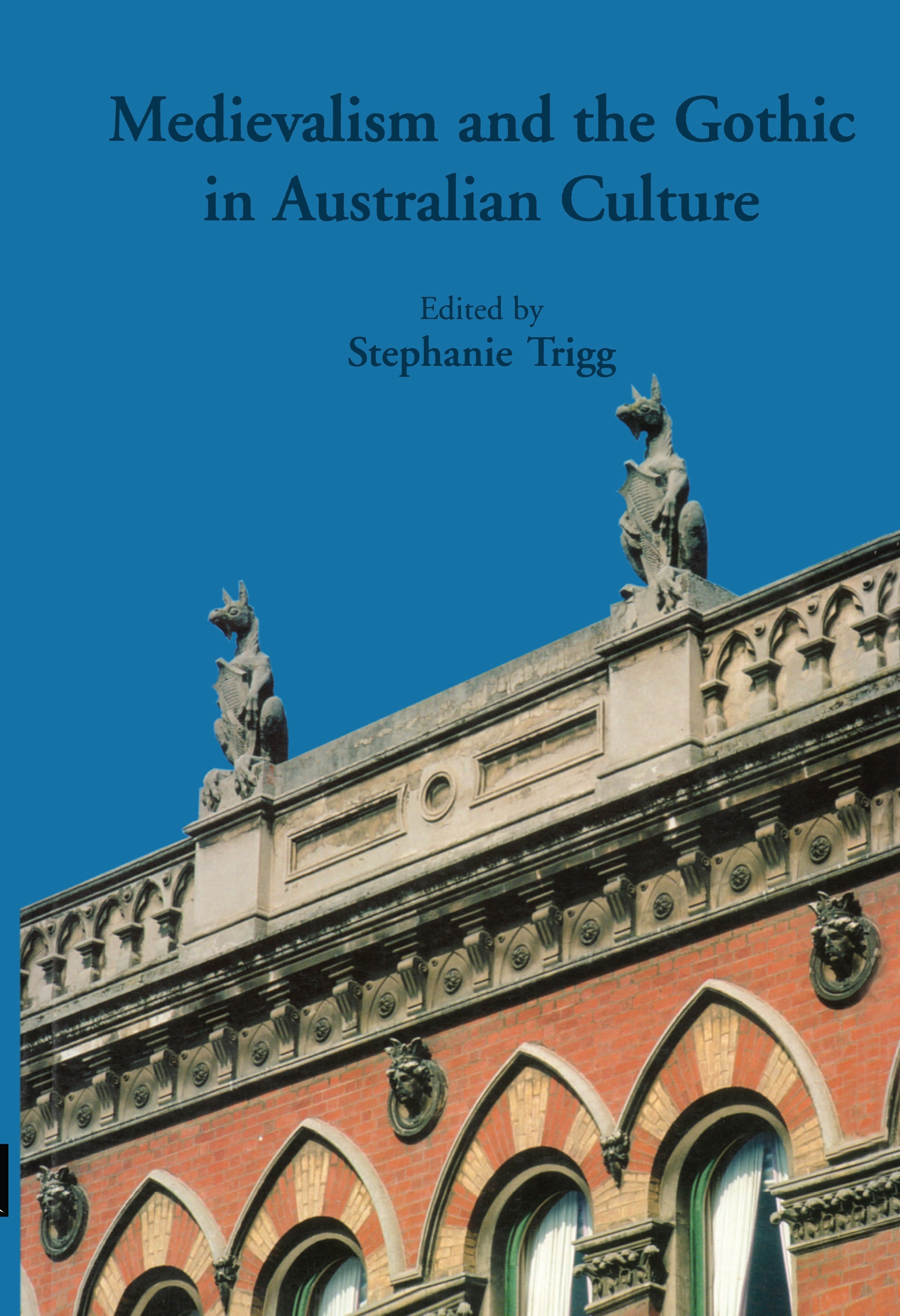
- Free Article: No
- Contents Category: Non-fiction
- Review Article: Yes
- Article Title: ‘But that the stone is fresh’
- Online Only: No
- Custom Highlight Text:
In her essay in this collection, Jenna Mead quotes from the work of a co-contributor, the Australian medievalist David Matthews. He tells a story which is likely to resonate in the memories of many of us who have, by choice or otherwise, studied medieval culture at university in this country. His tutor at the University of Adelaide, in the course of a seminar on Sir Gawain and the Green Knight, asked the class about the famous line which describes Bertilak’s castle: ‘Towres telded bytwene, trochet ful [th]ick.’ ‘Where might the nearest example of such an architectural feature be found?’ The class, suspecting some academic trick, fell silent, not making the imaginative connection to the tower of the administration building ‘about two hundred yards away’.
- Book 1 Title: Medievalism and the Gothic in Australian Culture
- Book 1 Biblio: MUP, $42.95 pb, 325 pp
- Book 1 Cover Small (400 x 600):

- Book 1 Cover (800 x 1200):

I suspect that very few of us who developed a passion for the literature, history and art of the Middle Ages perceived that what we were reading might have anything to do with our own historical and physical environment, much less our daily lives. In my own experience, the reverse was probably true: the ‘otherness’ of the Middle Ages – photographs of Carcassonne in the mist, postcards of illuminated manuscripts, recordings of Gregorian chant and so on – constituted its attraction. Like Nora Porteous, the heroine of Jessica Anderson’s Tirra Lirra by the River (1978), my fellow English Honours students and I were drawn to Astolat and Canterbury because they represented everything that our ‘raw but genteel town’ was not.
There’s a fine essay on Jessica Anderson’s Arthurianism, by Louise D’Arcens, in this splendid collection. It is in Part I of the book, whose contents explore various manifestations of the medieval and the Gothic in Australian writing, from Marcus Clarke (David Matthews), through Henry Kendall (Peter Otto) and Francis Webb (Andrew Lynch), to contemporary children’s books (Valerie Krips). The editor, Stephanie Trigg, is a Melbourne medievalist whose interests have moved from classical textual scholarship to the fascinating territory of how medieval books are read in changing ways through time and space, in response to the cultural perspectives of readers and authors. Her introduction to these fifteen essays has some illuminating things to say about how the terms ‘medievalism’ and ‘Gothic’ have a multiplicity of meanings, only the most obvious of which have to do with the establishment of historical categories. She comments on the difference between Australia’s appropriations and co-optings of the medieval and those traced in older settler cultures: whereas ‘Canada and the United States register a much greater impact from the Renaissance, seventeenth-century and Enlightenment thought … Australia conceives the historical past primarily under the sign of late eighteenth- and nineteenth-century Gothic, while also frequently invoking a mythologized medieval past.’ The essays on predominantly literary texts in the first part of her collection illustrate a variety of inflections of Australian Gothic. Andrew Lynch, for example, offers a penetrating historicised meditation upon ‘Around Costessey’, which shows how Webb’s intellectual and poetic thought departs from his English Catholic contemporaries’ kind of medievalism.
Mead’s ‘Medievalism and Memory Work’ bridges the two parts of this collection. Its subject is two of what she terms the ‘afterlives’ of medievalism in Australia: one the remnant towers of Joseph Archer’s colonial mansion ‘Panshanger’ near Longford in Tasmania; the other, the discipline of academic medievalism in this country. This interesting conjunction of topics works itself out through the author’s understanding of memory, which is keenly informed by postmodern praxis. Mead’s essay, more than any other, foregrounds questions of theory, although the insights provided by the work of, for example, the Subaltern Studies group can be traced in some of the other contributions to Part I of this volume. Part II – ‘Gothic Landscapes and Medieval Communities’ – is less insistently text-based, although Geraldine Barnes and Adrian Mitchell offer a brilliant account of the Mandevillian cast of mind that is filtered through William Dampier’s ‘witness’ to the melancholy horror show of New Holland. Several of the essays in Part II address responses to landscape and to the shaping of the antipodean Other through the mediums of the built form and other forms of monument-making. Sarah Randles’ ‘Medievalism and Australian Architecture’ is a fine companion piece to Mead’s discussion of Tasmanian Gothic in its exposition of three iconic examples of ‘Australian medieval’ architecture as nostalgic simulacra rather than accurate recreations of fourteenth-century buildings; her conclusion that the Australian buildings ‘participate in a kind of reverse colonisation, in which the medieval past is claimed for Australia, and the Middle Ages are rebuilt in the image of Australian medievalism’ is one of several testimonies that the book offers to the paradoxical vitality of medievalism cut loose from its historical roots. Dr Oldfield’s musings on Old St Mary’s by moonlight (1828) are testimony to that shaping power wielded by Gothic Romanticism, illustrated in the writing of Clarke, Kendall and Charles Harpur, and in the imaginings of Anderson’s Arthurian heroines: ‘The Gothic edifice, though a plain structure, is a surprising piece of work, standing where it does … yet the whole has a fine effect, and by moonlight, but that the stone is fresh, you might fancy it is some old abbey.’
The potency of medieval symbols and their cultural inscriptions, always in process of re-inscription, is charted in other essays. Victoria Emery discusses the rituals and ideals of ‘The Daughters of the Court’, that long-lost network of women’s clubs dedicated to self-improvement and to furthering the aspirations of women. It is interesting to see how the Daughters, predominantly middle class and professional, held a door open to working-class women. (Christine de Pizan, fifteenth-century proto-feminist, might well have taken her place beside the Countess of Hopetoun as patroness of the Order.) Megan Cassidy-Welch combines architectural, theological and sociological perspectives to examine the Cistercian community of Tarrawarra, in one of the few essays in the volume to look beyond the afterlives of a specifically English medievalism. ‘Performative medievalism’ is explored in different ways in the contributions of Adina Hamilton (who looks sympathetically at the organisation and activities of the Society for Creative Anachronism, too often dismissed as a bunch of woad-besmeared nutters), and Matthew Chrulew (Dungeons and Dragons). Ken Gelder’s lively account of the manifestations of one highly visible ‘dislocated national subject’ shows why the Goths continue to beat at the gates. In their essay, which concludes the volume, Stephanie Trigg and Paul James offer a welcome injection of vitality into the flagging debate about an Australian republic. Their particular take on collective memory-work develops a sophisticated understanding of how ‘the medieval’ can be co-opted by anyone who has the will to do so. It is fitting that the book should conclude by looking forward: ‘Australia does not look anything like a medieval society, yet the terms in which we frame our cultural and national identity are still powerfully driven by the complex legacy of medievalism.’


Comments powered by CComment